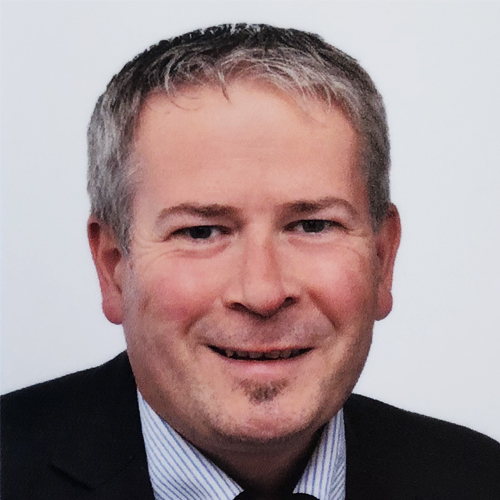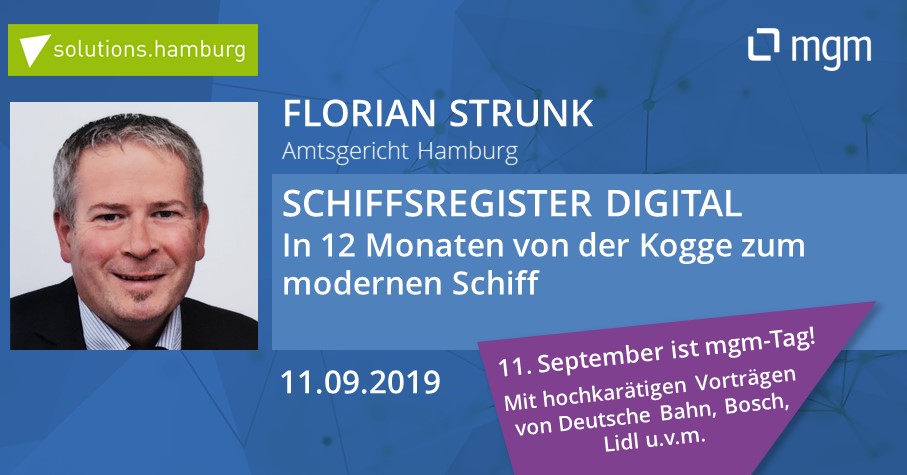Interview with Florian Strunk, head of IT at Hamburg Court
4866 seagoing vessels, 2177 inland waterway vessels, 42 ships under construction, 420 new registrations per year and approximately 3500 applications for existing vessels: The shipping register of the Hanseatic city located at the Hamburg Local Court is the largest in Germany. Previously, all work processes were carried out on paper. On September 11, Florian Strunk from Hamburg District Court explains how the complex processes can be converted into a digital application. In an interview with mgm, he gave an insight into the status of the project in advance.

Florian Strunk: The ship registers in Germany are globally unique because they are kept in the courts. According to German law, a ship is treated like a property. Just as a property is entered in the land register, a ship is entered in the ship register after it has been inspected by the court. This makes the whole process more complicated compared to other countries. In the Bahamas or Malta this is easier, but the German procedure offers the incredibly important legal certainty according to our value system, for example that nobody can be expropriated behind the scenes.
In contrast to other areas of law, you can choose your own jurisdiction in the ship register: The shipowner is free to decide in which shipping register he wishes to have his ship registered. And here we want to see that we maintain our competitive advantage here in Germany.
mgm: What other reasons are there for the digitisation of the ship register?
Florian Strunk: In the year 2019, an application processing in anachronistic form with paper, pencil, scissors and ruler is no longer imaginable. We need various exchange formats, and we also have a legal obligation to convert all our procedures outside the ship register and land registries to an electronic file by 2026. We don’t want to get any islands that are still working on paper.
mgm: How did you put this into practice?
Florian Strunk: In the past, there were always attempts to implement such a project. In the end, however, this always failed because a large preliminary project was started with requirement analyses and the creation of specifications, as is known from classic software development. Then it was determined The whole thing can’t be financed at all. And you have always waited for other developmental steps that you could have been involved in. As part of the city’s digitisation strategy, we commissioned another preliminary study to determine the extent to which it would be possible to create a digital register within a very tight timeframe and with a budget that is manageable by software standards, which would satisfy all the requirements we have in the judicial environment and which would also make use of the standard components of the judicial system. After a good six months of consideration, this preliminary study has come to the conclusion that this could actually be realised. And then – a novelty for Hamburg – a joint venture was created between the economic authority and the judicial authority, which wanted to realize this together. We wanted to present a product that both offers advantages to the judiciary and has advantages for our customers. This is the aspect represented by the economic authority that promotes Hamburg as a port location: that the shipowners who are based here also stay here and do not relocate.
mgm: What are the key success factors for ensuring that deadlines and budgets are met?
Florian Strunk: In any case, agile software development. To the best of my knowledge, this is really the first time that development has been so agile that it’s also noticeable that agile software development is behind it. The users are taken on board from the outset. So I don’t even have the situation that you know from many other projects, that people are working their way up and at some point you realize that you’ve left the users behind. And then, in principle, you have to turn back the clock by three months and go back to a previous milestone. It’s really different with us.
mgm: What is agile software development?
Florian Strunk: For me, agile software development means that I orientate myself to the actual circumstances when defining requirements, that I don’t have to rely on a possibly outdated requirement specification at the time of creation and that I can immediately adapt to newer developments, which can occur again and again during the course of the project, without wasting a lot of time and effort.
mgm: How do you do this in concrete terms, the integration of users?
Florian Strunk: We distinguish between the internal client and the external client. The internal client is the one the court staff will be working with. They are included in a sprint review every 14 days. This means: The developers of Dataport and mgm are composed of a circle of colleagues who will use the product in the future. They present the development, ask what is good and where there are suggestions for improvement, and also include requirements for the coming sprints in this review.
We held a kick-off event for the stakeholders at the economic authority. Stakeholders are those who will use the external client, e.g. lawyers, banks, shipowners and shipbrokers. At the event, we presented the project and also asked what the stakeholders actually expect from such a product. And we regularly keep those who have an address with us up to date on the development of the external client.
mgm: Where in the development process between start and release are you at the moment?
Florian Strunk: So far it has been the case that employees are involved in the 14-day reviews, and if they like, they can always switch to the product in between and watch and try it out. Now to 31.7. we will install the first prototype on site with the colleagues, so that they always have it available parallel to their work. Then they can always check in agreed steps whether they can also display in the application what is currently to be processed in the classic form.
mgm: How did the integration of external service providers work?
Florian Strunk: I am very sure that without an external view of the processes of someone who is not from the public sector and has such a driving character, we would not be where we are today. At least not in this time.
mgm: Would the digital ship register also be interesting for other federal states?
Florian Strunk: Other federal states are definitely interested in our solution. The colleagues there had not previously thought it possible for us to implement the project so well.
The fact that we do not have to coordinate with 15 federal states is another important success factor. Other projects in this area take a very, very long time, because 16 countries always have to vote on something. It’ll kill any software project. It’s a really pleasant story here, to be able to show something fast.







